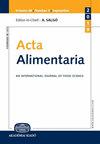不同健康状况母亲母乳中脂肪酸组成的气相色谱测定
IF 1
4区 农林科学
Q4 FOOD SCIENCE & TECHNOLOGY
引用次数: 1
摘要
健康、营养良好的哺乳期母亲的母乳是独特而理想的营养因子来源,如激素、细胞因子、趋化因子、生长因子,可确保婴儿的正常生长和发育。在HM的主要成分中,脂肪是重要的能量来源和调节因子。乳脂的质量取决于其脂肪酸(FA)组成。气相色谱与火焰电离检测相结合是分析HM的FA谱图最常用的方法之一。本研究的目的是评估来自不同健康状况(正常体重指数(nBMI);超重和肥胖)。结果表明,饱和脂肪酸在HM样品中含量最高,以棕榈酸为主要代表。单不饱和脂肪酸主要是油酸,而亚油酸是多不饱和脂肪酸(PUFA)中含量最多的。超重和肥胖的女性母乳中的多聚脂肪酸含量较低。数据进行主成分分析和二次判别分析(QDA)。QDA对nBMI和超重、肥胖母乳样本的分类准确率为88.24%。在C10:0和C18:3 FAs情况下,正常、超重和肥胖HM样本之间存在显著差异。较高的母亲BMI与较高的n-6/n-3 PUFA比率相关。本文章由计算机程序翻译,如有差异,请以英文原文为准。
Gas chromatographic determination of fatty acid composition in breast milk of mothers with different health conditions
Human milk (HM) of healthy, well-nourished, lactating mothers is a unique and ideal source of nutritive factors, like hormones, cytokines, chemokines, growth factors that ensures the proper growth and development of infants. Among the main components of HM, fat is an important energy source and a regulatory factor. The quality of milk fat depends on its fatty acid (FA) composition. Gas chromatography coupled with flame ionisation detection is one of the most common methods for analysis of the FA profile of HM. The aim of this study was to evaluate the FA composition of HM, collected from mothers with different health conditions (normal Body Mass Index (nBMI); overweight and obese) using GC-FID method. The results showed that saturated FAs were present in the highest amount in the HM samples, of which palmitic acid was the main representative. The major monounsaturated FA was oleic acid, while linoleic acid was the most abundant of the polyunsaturated FAs (PUFA). Overweight and obese women have lower levels of PUFA in their breast milk. The data were subjected to principal component and quadratic discriminant analysis (QDA). QDA classified nBMI and overweight and obese mother milk samples with 88.24% accuracy. Significant differences were found between normal and overweight and obese HM samples in case of C10:0 and C18:3 FAs. Higher maternal BMI was associated with a higher n-6/n-3 PUFA ratio.
求助全文
通过发布文献求助,成功后即可免费获取论文全文。
去求助
来源期刊

Acta Alimentaria
农林科学-食品科技
CiteScore
1.80
自引率
0.00%
发文量
47
审稿时长
18-36 weeks
期刊介绍:
Acta Alimentaria publishes original papers and reviews on food science (physics, physical chemistry, chemistry, analysis, biology, microbiology, enzymology, engineering, instrumentation, automation and economics of foods, food production and food technology, food quality, post-harvest treatments, food safety and nutrition).
 求助内容:
求助内容: 应助结果提醒方式:
应助结果提醒方式:


